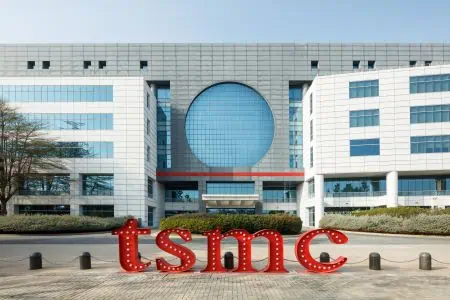
By Bolaji Ojo
Taiwan Semiconductor Manufacturing Co. Ltd. (TSMC) has long championed a manufacturing philosophy often at odds with the industry’s more speculative instincts: it expands capacity only for confirmed customer orders. This “build-to-order” discipline has been instrumental to TSMC’s resilience, helping it navigate the volatility that routinely roils the semiconductor sector.
For decades, while the global semiconductor industry rode waves of boom and bust, TSMC stuck almost stubbornly to this policy, going as far as including comments about it in its filings with the US Securities and Exchange Commission (SEC). In a sector notorious for euphoric excess and painful crash, this discipline has delivered not just resilience but distinct competitive advantage.
The wisdom of TSMC’s strategy is clear for those who recall how the semiconductor sector’s cycles have unfolded. In every period of explosive demand, manufacturers ramp up production, lured by visions of endless growth. But all too often, upturns breed overconfidence, leading to widespread overbuilding.
The consequences are predictable and severe: excess inventory, dubious or duplicate orders, price wars, factory underutilization, and painful write-downs. The early 1980s saw rampant overbuilding in memory chips, with prices crashing as rivals struggled to offload surplus inventory.
A generation later, in the aftermath of the dot-com bust, the same mistakes played out. Factories meant to serve what seemed like infinite internet growth sat idle or were written off as demand collapsed. History repeated after the COVID-related chip shortage. The surge spurred a global rush to expand capacity, only for a wave of inflation and weak consumer demand to swiftly turn the tables, leaving many fabs underutilized and suppliers grappling with waves of excess inventories.
Intel’s volte face
TSMC’s approach has won a high-profile convert: Lip-Bu Tan, CEO of Intel. Tan’s public commitment to abandoning expensive, speculative supply-led expansion marks a pivotal moment for Intel. He recently delivered a message of humility to the IC market, noting that he will personally approve all major manufacturing projects, prioritizing tangible demand over sheer scale, and pausing high-profile projects in Germany and Poland until clients are in place.
The company is also slowing construction activities at the mega plants it is building in Ohio. To drive home the point, Intel has hinted it may cancel its 14A process technology if it does not secure pre-purchase orders. “Over the past several years, the company invested too much, too soon, without adequate demand,” Tan said, while announcing Intel’s latest financial results. “Consequently, our factory operations became unnecessarily fragmented and underutilized. We must adjust our strategy.”
Tan added: “There are no more blank checks. Every investment must make economic sense. Construction … will now slow and proceed based on market demand and confirmed customer commitments.”
This very public pivot, on the heels of billions of dollars spent or planned and the delay of megaprojects, signals a sea change. Intel, long known for betting big on the future and building capacity in anticipation of demand, is now aligning its expansion with the kind of discipline TSMC has practiced for decades.
The underlying logic is simple. Order-backed investments ensure fabs run at high utilization rates and generate healthy returns. Revenues and margins become more stable, as contracts with major tech customers create predictable cash flows. The company avoids the downward spiral of discounting prices to shift oversupply and spares itself the temptation to take on risky projects merely to fill excess capacity.
Geopolitical pressures
Of course, the current investment climate threatens to resurrect old mistakes under a new banner. Governments in the US, EU, and China are channeling billions of dollars in subsidies toward new fab construction to strengthen supply security. But public incentives carry their own risks: the possibility that the flood of new facilities will again outpace demand, sparking the very excesses and price declines they seek to avoid.
These risks are tangible, and the semiconductor cycles remain as punishing as ever. Even surging demands for AI, advanced memory, and automotive chips have their own idiosyncrasies. Much of the industry, including legacy nodes and consumer applications, remains highly exposed to classical supply-and-demand mismatches. And no amount of speculative optimism around the next must-have technology can suspend the iron laws of inventory and price competition.
Overcapacity inflicts more than bruised egos and financial losses. It leaves factories sitting idle after billions of dollars have been expended in construction costs, and those stranded assets weigh down balance sheets for years. Companies, in desperation, may try to salvage investments by cutting prices, undermining profitability and discouraging innovation. Persistent gluts often force layoffs or even the closure of entire plants, destroying expertise and morale. If the cycle persists, even industry leaders can stumble.
Throughout its history, TSMC has largely avoided these pitfalls by resisting the temptation to overbuild. The company’s discipline has not only kept it profitable through more than 15 industry downturns but also allowed it to maintain a technological edge. There is flexibility, too, in not being tied to underused legacy facilities; resources can be targeted at the next generation of chip technologies, rather than sunk into salvage operations.
TSMC’s approach does not mean shying away from ambition, but it avoids the recklessness that has plagued rivals. By aligning expansion with real customer commitments, it maximizes the return on every dollar invested and shields itself from both cyclical excess and sudden slowdowns.
The memo to TSMC is to steer clear of fads, hold fast to customer-driven growth, and let others rediscover the painful lessons of unbridled optimism. The company has built or is expanding fabs in North America and Japan. Anything more than these, at this moment, could prove disastrous down the line.
TechSplicit‘s message to TSMC is simply this: Do not change the recipe, at least, not by much.
Bolaji Ojo is publisher and editor-in-chief of TechSplicit. He can be reached at bojo@techsplicit.com.
Copyright permission/reprint service of a full TechSplicit story is available for promotional use on your website, marketing materials and social media promotions. Please send us an email at talktous@techsplicit.com for details.
